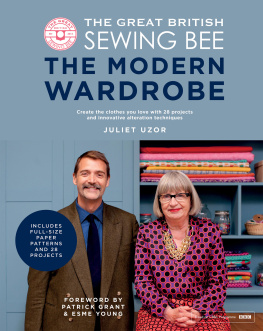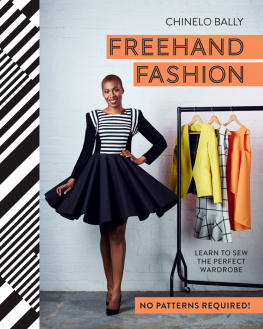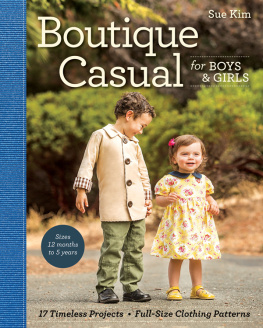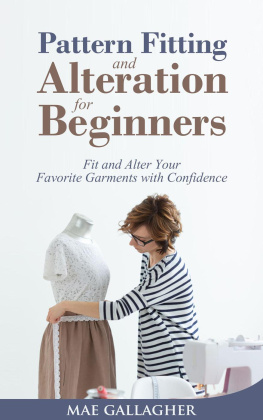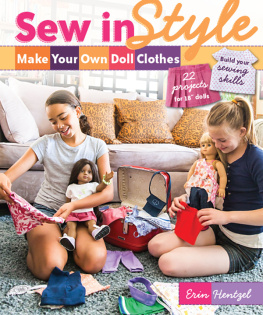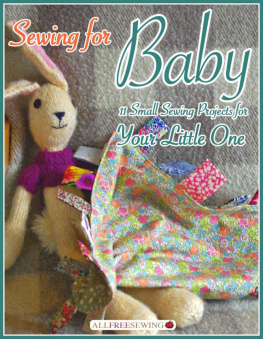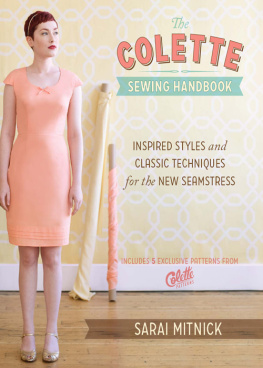

I never actually set out to have a career in fashion, but its been a major part of my life for more years than I care to remember. Never in my wildest dreams, however, would I have imagined that making clothes would be the subject of a prime-time television series let alone that Id end up judging The Great British Sewing Bee for (at the time of writing) eight whole series! But I love seeing how every contestant brings their personal style to the challenges we set them. Even though they all start from the same base pattern, it never ceases to amaze me that the garments look so different. Yes, of course the technical side is important I certainly dont want to see raw edges or gaping holes in seams or garments that sag or pinch in all the wrong places. But when individuality and creativity combine with technical prowess, then youve got something really special.
Maybe thats one of the reasons why The Great British Sewing Bee is so popular those magical moments when, despite all the drama and angst, everything comes together and you end up with not just a flawless piece of sewing but with colour or fabric combinations that make your heart sing. Its certainly what gives me the biggest buzz. Every single series, I see something completely new and innovative that inspires me in my own work. I hope this latest Sewing Bee book will encourage you to try out new styles and techniques for yourself and, whether youre a relative newcomer or someone whos been making clothes for years, help you on your sewing journey.

Sewing is such a meditative process you have to slow down and focus, blocking out any other distractions, and thats got to be good for your health and wellbeing. Whats more, youre always learning something. Ive been sewing since I was seven, when I was taught to sew at school, but Im still learning and in my eyes the biggest mistake any sewist can make is to think they know it all, because no one ever can.
I can still remember the first thing I made a red gathered skirt that I must have sewn by hand, because we didnt have sewing machines. It probably wasnt anything special, but I was so proud of it! That joy has never left me. Sewing is creative you start out with a flat piece of fabric that you turn into something three-dimensional and you really feel as if youve achieved something.
Since that first red skirt, Ive gone on to study graphics at Central Saint Martins in London, worked as a fashion designer and costume maker in films, and now Ive come full circle. Im back at Central Saint Martins teaching pattern cutting and all of these widely differing experiences feed into my judging on The Great British Sewing Bee. So what do I look for as a judge? Well, I look for attention to detail: beautiful seams, even hems, good pattern matching, carefully chosen trims, no puckering. And as regular viewers will know, I do love a big bow! I want everything to be perfect, but I also want to be surprised; above all, I want to see the contestants personalities show through in their choice of fabric, their choice of colours, the sewing techniques they use. Ive always encouraged the Great British Sewing Bee contestants to make something from scratch to their own taste and style rather than using a shop-bought pattern and I urge you to do the same. So use the patterns in this book as a starting point, then mix and match different elements to come up with something thats truly yours. Once youve taken the plunge and started deviating from the official pattern, I promise you youll find it thoroughly liberating and your creativity will flourish!
This latest Great British Sewing Bee book sub-titled The Modern Wardrobe features patterns for a core wardrobe of garments, from a simple A-line skirt and casual trousers to more tailored dresses and blouses. There are some garments that you may recognize from the TV show, while others have been created especially for this book, but all the designs lend themselves to the creation of different items of clothing so once youve tried out the base patterns, you can alter them to add personal touches and customize the designs.
Ive grouped together garments that are similar in construction or technique to give you some idea of the range of options available to you. Ive included patterns for all the garments in the book, so you can follow them to the letter if you want to but for those of you whod like to branch out a little, Ive also dropped in some ideas on how you can ring the changes and make something truly your own. Some alterations are obvious for example, you could lengthen a basic top to create a simple shift dress or add a patch pocket to a skirt front. Youll also see how making the same pattern in a different weight of fabric can completely change the look, as in the .
Other adaptions require a little more planning and for these its a good idea to , or even slash through a bodice to add a style line.
I hope this approach will allow you to use the patterns to their full potential and thats surely the aim of all home sewers looking to create beautiful pieces for their wardrobes without breaking the bank. Use this book for inspiration to create clothes that you love the options are endless!


PATTERNS TO ACCOMPANY THE BOOK
This book comes with full-scale patterns nested in multiple sizes, which can be downloaded as a PDF at https://www.hardiegrant.com/uk/quadrille/themodernwardrobe for you to print at home or at a copy shop.
The pattern pieces are layered on top of each other ready for tracing. Trace them onto dressmakers carbon paper, making sure you follow the lines for your size, then cut out. You will find information on to fit your body shape and grading patterns between sizes.
The outside lines on the pattern pieces are the cutting lines. Different sizes have different line types such as solid, dotted or dashed, which are also numbered by size. In some areas the lines merge, so it is advisable to go over your size line with a coloured pencil before tracing.

TOP TIP
In the step-by-step illustrations accompanying the projects, the right of the fabric is shown as a dark tone and the wrong side as a light tone.
LAY PLANS
The lay plans included in this book indicate how each project should be cut out where the grain line on the pattern should be placed, whether pieces should be cut on the fold or not. Check each lay plan when pinning your pattern pieces to your fabric.
The majority of the projects in this book are to be cut with the fabric folded in half right side to right side, with the selvedges together, so that you get perfectly symmetrical pieces when cutting on the fold and perfectly matching pairs when cutting two pieces that need to be identical (such as sleeves). If just a single pattern piece is to be cut, rather than a pair, that piece is coloured grey on the lay plans. Occasionally you are required to cut the fabric flat, and not on the fold. This is the case when a pattern piece is wider than the folded fabric. These lay plans are labelled single layer.

